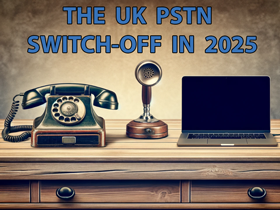
There is a major change coming to phone systems across the UK in 2025 – we will all have to use digital phone services.
What is happening?
The UK’s phone network is being upgraded – every landline cable is switching to faster, more reliable and responsive Internet Protocol (IP) technology. To use the IP network, any systems connected to a Public Switched Telephone Network (PSTN) or Integrated Services Digital Network (ISDN) phone line will need to be moved to a IP-based service.
At Trichromic we understand that not everyone is aware of this change and what it means to them. So, over the next few weeks we will be giving you the facts about this change and what you need to do to maintain your business communication systems.
The world of telecoms is full of confusing acronyms, especially when it comes to line rental. PTSN, ISDN, SIP, VoIP – what do all these acronyms mean? And which one is right for your business?
Here are the main differences between the big three: PSTN, ISDN and SIP.
PSTN
The Public Switched Telephone Network (PSTN) is the traditional copper wire telephone system, originally set up for analogue voice communication. It’s been in place since the late 1800s and although it’s been maintained and updated over the years, the technology underpinning it has essentially remained the same since its conception.
PSTN was the most popular and reliable method of making and receiving voice calls. But now it’s old-fashioned and getting too expensive to maintain and operate.
ISDN
Back in the late 80s, Integrated Services Digital Network (ISDN) was introduced due to the need for a more stable, secure connection for long-distance calling. It’s a digital version of a traditional telephone line, allowing for the transfer of voice and data simultaneously over PSTN copper wires.
It was clearer with higher quality calling and less distortion than PSTN and allowed data to be sent and received quicker. Although it still used the older lines, it was a welcome improvement. Plus, with speeds of up to 128kbps, it was the ultra-fast internet the 1980s needed, setting the trend for more advanced (and exponentially faster) solutions later down the line.
Unfortunately, this technology is starting to show its age. New broadband technology has revolutionised voice communications and removed the need for costly, outdated analogue wiring, in favour of complete digital functionality.
SIP/VoIP
Session Initiation Protocol (SIP) and Voice over Internet Protocol (VoIP) are the latest replacements for PSTN and ISDN lines. VoIP is a broad term, and essentially means voice transmitted through the internet, rather than over traditional lines. SIP is the industry preferred protocol of achieving VoIP connections and extends your functionality by allowing you to send a range of multimedia data (e.g. messaging and video) over VoIP.
VoIP sets the new standard for voice communications. Calling is initiated over the internet, so your phone system moves with your business. It also simplifies features such as conference calls and call forwarding as everything is on one data network instead of dedicated phone lines. This makes it more efficient and scalable than any other system.
What next?
There is a lot to take in here and these changes are on the horizon (2025). We will be sending more information to you over the coming weeks but, these phone systems are here already – the big switch off is the final whistle, not ‘half time’. You can and should start planning how to tackle this issue as soon as possible.
Trichromic can advise on, supply, and maintain these new systems – if you would like to speak with one of our friendly experts, please contact us on: 02033270310